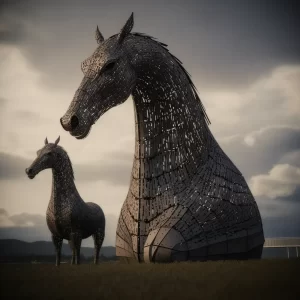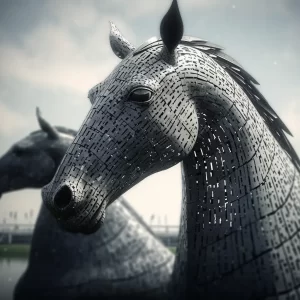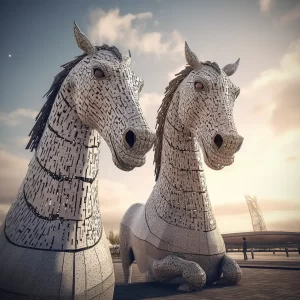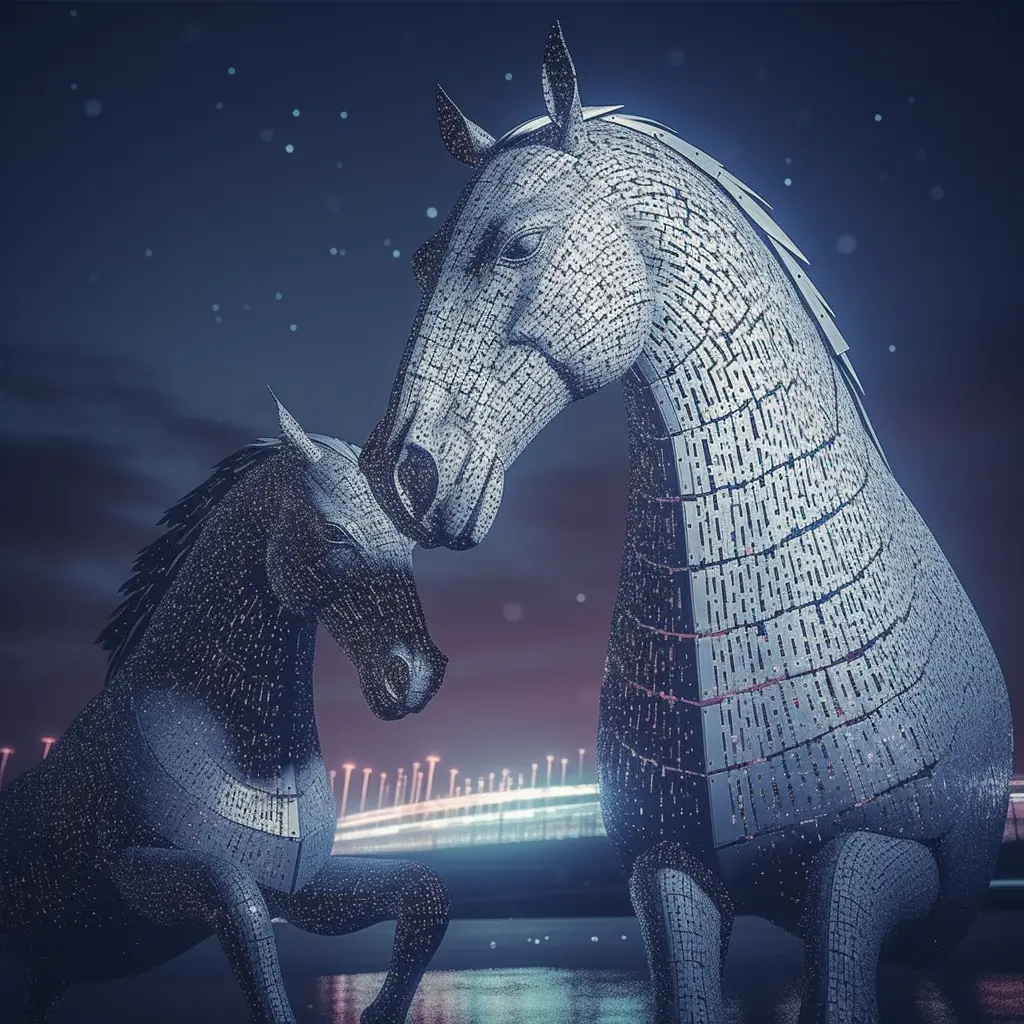Kelpie mythology is a fascinating topic for those interested in Scottish and Irish folklore. Kelpies are shape-shifting spirits that are said to inhabit lochs and rivers, often taking the form of a black horse-like creature. They are known for their malevolent nature and their love of drowning their victims.
The name “kelpie” may come from the Scottish Gaelic words “cailpeach” or “colpach”, meaning heifer or colt, and is often used interchangeably with the term “water horse”. In some stories, kelpies are said to be able to take on a human form, making them even more dangerous and difficult to identify.
While kelpies are most commonly associated with Scottish and Irish folklore, similar creatures can be found in mythology and legends from around the world. The kelpie’s ability to shape-shift and its association with water and drowning make it a fascinating and terrifying figure in mythology that continues to capture the imagination of people today.
Origins of Kelpie Mythology
The Kelpie is a shape-shifting water spirit of Scottish folklore, said to haunt rivers and streams, usually in the form of a horse. The exact origins of Kelpies mythology remain uncertain, but it is believed to have its roots in ancient Celtic and Scottish mythology.
Some historians and symbologists have hypothesized that the Kelpie myth might originate with the water spouts that can form over the surface of Scottish lochs, giving the impression of a living form as they move across the water. Others believe that the Kelpie might have been inspired by the ancient Celtic goddess Epona, who was associated with horses and water.
The Kelpie is often depicted as a malevolent creature, delighting in causing drownings and luring unsuspecting travelers into the water. In some stories, the Kelpie is said to take on a human form to seduce and drown its victims. It is also said to have a particular fondness for human liver.
Despite its fearsome reputation, Kelpie Mythology is also seen as a symbol of Scotland’s rich folklore and cultural heritage. Today, the Kelpie remains a popular figure in Scottish mythology and is often depicted in art, literature, and film. The Kelpies, two 30-meter-high horse head sculptures in Falkirk, Scotland, are a modern tribute to this ancient mythological creature.

Physical Description of Kelpies
Kelpies are mythical creatures that are usually depicted as a powerful and beautiful black horse. They are often associated with water and are said to inhabit lochs, rivers, and streams in Scottish and Irish folklore. Kelpies are known for their ability to shape-shift and can take on a human form, although they are most commonly seen in their equine form.
In their equine form, kelpies are described as having a muscular build and a glossy black coat. They have powerful hooves and a long, elegant neck. Their eyes are said to be wild and fiery, and their mane and tail are made of bulrushes. Kelpies are often portrayed as being larger than an average horse, and their presence is said to be both awe-inspiring and terrifying.
As mentioned earlier, Kelpies are known for their ability to lure unsuspecting humans and animals into the water, where they drown their victims. They are also said to delight in eating human flesh, particularly the liver. However, despite their fearsome reputation, kelpies are also seen as symbols of fertility and power.
Their equine form is powerful and beautiful, while their ability to shape-shift and lure unsuspecting victims into the water adds an element of danger and fear to their legend.
Kelpies in Different Forms
Kelpies are shape-shifting water spirits that are said to inhabit the lochs and rivers of Scotland. They are often depicted as black horse-like creatures that can transform into human form. In some stories, they are also known to take on the appearance of other animals, such as seals or otters.
One of the most common forms of the kelpie is that of a horse. They are known as water horses and are said to lure people to ride them before dragging them into the water to drown. Kelpies are also known to take on human form, often appearing as an attractive young man or woman. In this form, they can seduce their victims before revealing their true nature and dragging them into the water.
The kelpie is not the only shape-shifting water spirit in Scottish mythology. The Each Uisge is another water horse that is said to inhabit the lochs and rivers of Scotland. Like the kelpie, it is said to lure people onto its back before dragging them into the water. The Selkie is another water spirit that is said to take on the form of a seal. In this form, they are said to be able to shed their skin and take on human form.
Kelpies are often portrayed as malevolent creatures that delight in drowning their victims. They are said to be particularly dangerous during storms or at night, when they are more likely to be able to lure people into the water. Despite their malevolent nature, kelpies are also said to be capable of granting wishes to those who are able to capture them.
While they are often portrayed as malevolent creatures, they are also said to be capable of granting wishes to those who are able to capture them.

Kelpie Habitations
One of the most famous lochs in Scotland, Loch Ness, is said to be home to a kelpie known as the Loch Ness Monster. However, it is important to note that the existence of the monster is still a matter of debate and has not been confirmed.
Kelpies are also said to inhabit bodies of water in the Orkney and Shetland regions of Scotland, where they are known to be particularly malevolent and dangerous.
Despite the dangers associated with kelpies, they are also known to be shapeshifters who can take on the form of a beautiful woman or a magnificent horse. In some cases, they may even take on the form of a human, making them difficult to identify and avoid.
Kelpie Victims
In Scottish folklore, they are said to be particularly fond of children and young women. Kelpies often appear as a grey or white pony with a dripping mane, and they entice their victims to ride on their back before taking them down to a watery grave.
Young men are also often targeted by kelpies. They are said to be attracted to their strength and virility. Kelpies have been known to appear to young men as beautiful women, luring them into the water where they drown.
Kelpies are known to be very cunning and deceptive. They often appear to their victims as friendly and harmless creatures, only revealing their true nature once it is too late. Victims of kelpies are often unable to escape, as the creatures are incredibly strong and able to drag them under the water.
Drowning is a common theme in kelpie mythology, as it is the fate that befalls most of their victims. The creatures are said to delight in drowning their victims, and they often drag them down to the bottom of the loch or river to consume their flesh.
Kelpie Interactions
According to legend, Kelpies can only be tamed with a bridle made from seaweed. Those who are able to catch a Kelpie and place the bridle on it can then ride the creature without fear of drowning. However, this is a dangerous task, as Kelpies are notoriously difficult to catch and can easily drag their captors into the water.
In some tales, Kelpies are said to allow humans to saddle them and ride them without incident. However, this is seen as a rare occurrence and is not to be taken lightly.
When it comes to dismounting a Kelpie, caution must be exercised. If a rider attempts to dismount the creature before it has reached the water, the Kelpie may become enraged and drag the rider into the water. It is recommended that riders wait until the Kelpie has reached the water before dismounting.
Kelpies are also known to “nuggle” with humans, a term used to describe the creature rubbing its head against a person’s chest or neck. While this may seem like a friendly gesture, it is actually a way for the Kelpie to determine the strength of its potential victim.
In certain stories, Kelpies are said to have a particular affinity for ponies, heifers, and colts. They are known to lure these animals into the water, where they are drowned and devoured by the Kelpie.
Kelpie in Art and Literature
Kelpies have been a popular subject in art and literature throughout Scottish history. The myth of the Kelpie has inspired many artists and writers to create their own interpretations of the creature.
One of the most famous artistic representations of the Kelpie is the monumental steel sculpture, The Kelpies, created by artist Andy Scott. The sculptures stand at 30 meters high and are located in Falkirk, Scotland. The Kelpies were completed in 2013 and have since become a popular tourist attraction. The sculptures are a modern interpretation of the ancient myth of the Kelpie and are a testament to the enduring appeal of this mythical creature.
The Kelpie has also been referenced in literature, with Scottish poet Robert Burns mentioning the creature in his poem, “Address to the Deil.” The Kelpie is described as a malevolent spirit that haunts rivers and streams, taking the form of a horse to lure unsuspecting victims to their doom.
Stones have also played a role in the mythology of the Kelpie. According to legend, Kelpies would place stones in their manes, which would then become enchanted. These stones were said to have magical powers and were highly prized by those who could obtain them.
Kelpie in Other Cultures
In Germanic mythology, there is a water spirit called the Nixie, which is similar to the Kelpie. The Nixie is a malevolent water sprite that is said to lure humans to their deaths by drowning.
In Scandinavia, there is a similar creature called the Nykur, which is a shape-shifting water spirit that often takes the form of a horse. The Nykur is known to be a dangerous creature that lures people into the water to drown them.
In Wales, there is a water spirit called the Ceffyl Dŵr, which is a water horse that is said to haunt the rivers and lakes of Wales. The Ceffyl Dŵr is known to be a dangerous creature that lures people into the water to drown them.
In Cornwall, there is a water spirit called the Bucca, which is a shape-shifting spirit that can take the form of a horse or a bull. The Bucca is known to be a mischievous spirit that can sometimes be dangerous to humans.
In the Kabyle mythology of Algeria, there is a water spirit called the Aghni, which is a shape-shifting creature that can take the form of a horse or a bull. The Aghni is known to be a dangerous creature that lures people into the water to drown them.
In Scandinavia, there is a similar creature called the Bäckahäst, which is a water horse that is said to lure people into the water to drown them. The Bäckahäst is known to be a dangerous creature that can only be tamed by someone who is able to ride it.
In Australia, there is a creature called the Bunyip, which is a water spirit that is said to inhabit swamps, billabongs, creeks, and rivers. The Bunyip is often described as a large, fearsome creature that is capable of killing humans.

Famous Kelpie Stories
One of the most well-known Kelpie stories is the tale of Tangie, a Kelpie that lived in the River Spey. According to legend, Tangie would lure unsuspecting travelers into the river, where they would drown. The story goes that a man named Walter Gregor was able to capture Tangie by using a bridle made of seaweed. He then used the bridle to control the Kelpie and force it to do his bidding.
Another famous Kelpie story involves the MacGregor clan. According to legend, the clan was able to capture a Kelpie and force it to do their bidding. They used the Kelpie to transport heavy loads, and it became a valuable asset to the clan. However, the Kelpie eventually escaped and returned to the river.
John Gregorson Campbell, a Scottish folklorist, wrote extensively about Kelpies in his book, “Superstitions of the Highlands and Islands of Scotland”. He collected many stories about Kelpies from various parts of Scotland, including tales of Kelpies that could transform into human form and lure people to their deaths.
Katharine Briggs, another Scottish folklorist, also wrote about Kelpies in her book, “An Encyclopedia of Fairies”. She described Kelpies as malevolent creatures that could take on the form of a horse or a human. She also noted that Kelpies were often associated with water and were said to haunt rivers and streams.
Lewis Spence, a Scottish historian and folklorist, included a section on Kelpies in his book, “The Magic Arts in Celtic Britain”. He described Kelpies as shape-shifting water spirits that were often associated with death and drowning.
Finally, Mackillop’s Dictionary of Celtic Mythology notes that Kelpies were sometimes associated with Douglas, a town in South Lanarkshire, Scotland. According to legend, a Kelpie lived in a nearby loch and would occasionally emerge to terrorize the local villagers.
Kelpie Warnings and Precautions
Given the danger that Kelpies pose, it is essential to take precautions when near bodies of water. Here are some tips to keep in mind:
- Avoid getting too close to the water’s edge, especially if you are alone.
- Keep a close eye on children and pets around bodies of water.
- If you do need to cross a river or stream, do so with caution and only at designated crossing points.
- If you encounter a horse near the water, be wary, as it could be a Kelpie in disguise.
- If you do suspect that a Kelpie is nearby, do not attempt to approach it, as it is likely to be dangerous.
While Kelpies are often associated with evil and Satan in Scottish mythology, it is important to note that they are simply one of many malevolent entities in the folklore of the region. Other dangerous creatures include the Wihwin, Calpa, Shoopiltee, and various serpents.
In Scottish Gaelic, the word “cailpeach” or “colpach” means heifer or colt, which is believed to be the origin of the name “Kelpie.” Some legends also suggest that Kelpies can be identified by their distinctive nose, which is said to be constantly dripping with water.
Magical Powers of Kelpies
Kelpies are known for their supernatural abilities and magical powers. These shape-shifting water spirits are capable of adopting various forms, including that of a horse or a human. The following are some of the magical powers attributed to Kelpies:
- Shape-Shifting: Kelpies are known for their ability to change their form at will. They can take on the shape of a horse, a human, or any other form they desire. This power allows them to blend in with their surroundings and remain undetected.
- Strength: Kelpies are incredibly strong creatures, capable of dragging humans and other animals into the water. They use their strength to overpower their victims and drown them.
- Singing: Kelpies are said to have a beautiful singing voice, which they use to lure humans and other creatures into the water. Once their victims are within reach, the Kelpies use their strength to drag them under.
- Mort and Nixie: Kelpies are sometimes associated with other water spirits, such as Mort and Nixie. Mort is a malevolent water spirit that is known for drowning humans, while Nixie is a mischievous water spirit that enjoys playing tricks on humans.
Frequently Asked Questions
What are the powers of the Kelpie?
The Kelpie is a water horse spirit of Scottish myth that has shape-shifting abilities. It is said to inhabit the lochs and pools of Scotland and can take on the form of a horse or a human. The Kelpie is known to delight in drowning its victims and, in some stories, has a particular fondness for human liver.
What is the myth of The Kelpies?
The Kelpie is a shape-changing aquatic spirit of Scottish legend that usually takes the form of a horse. It is believed to haunt rivers and streams and has been known to lure unsuspecting travelers to their doom. In some versions of the myth, the Kelpie can only be tamed by a human who is able to catch and hold onto its bridle.
What is the symbolism behind Kelpies?
The Kelpie is often seen as a symbol of the dangers that lurk beneath the surface of the water. It represents the unknown and the uncontrollable forces of nature that can claim the lives of even the most experienced travelers. The Kelpie is also seen as a symbol of power and strength, as well as a warning against the dangers of greed and desire.
What is the human form of the Kelpie?
The Kelpie is said to be able to take on the form of a human, usually that of a beautiful woman. In this form, it is able to lure men to their deaths by drowning them in the water. The human form of the Kelpie is often described as being incredibly seductive and alluring, with a voice that can charm even the most wary of travelers.
Are Kelpies only found in Scottish mythology?
The Kelpie is found in both Scottish Mythology and Irish Mythology. It is believed to have originated in the Scottish Highlands, where it was often used as a cautionary tale to warn travelers of the dangers that lay ahead.
What are some facts about Kelpies?
- Kelpies are said to be able to transform into any shape they desire, but they most commonly take on the form of a horse or a human.
- The Kelpie is often depicted as a black horse with a bridle made of seaweed.
- The Kelpie is believed to be able to control the water and is often associated with storms and floods.
- In some versions of the myth, the Kelpie is said to be able to grant wishes to those who are able to catch
To learn more about Kelpies Mythology, check out this video below:


